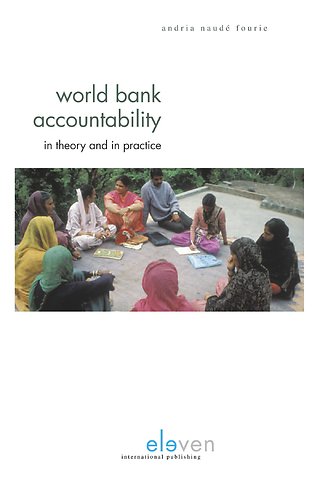World Bank Accountability
in theory and in practice
Samenvatting
International financial institutions such as the World Bank should be accountable – but to whom and for what? What role is there for legal and social normativity to influence, prescribe and assess behaviour and, ultimately, realize specific outcomes? How do we answer such questions in theory and how do we implement the answers to such questions in practice?
Focusing on the World Bank’s development-lending operations, this book considers these matters – specifically through the perspectives offered by the Bank’s citizen-driven accountability mechanism: the Inspection Panel. The book analyzes various interests, demands, expectations and conceptions surrounding the multidimensional notion of ‘accountability’ – thereby demonstrating why, in a diverse and dynamic world, accountability questions remain both relevant and challenging to answer conclusively. With its emphasis on theory and practice, this book is aimed both at researchers studying and practitioners working in transnational regulatory governance contexts involving multiple actors, politico-legal systems and forms of normativity. With its compendium of challenges characterizing Bank-financed development projects, this book can also introduce students of various disciplines to the operations of multilateral development banks.
Trefwoorden
Specificaties
Inhoudsopgave
Table of figures xv
Introduction
1 Towards a Comprehensive Shared Understanding on World Bank Accountability – in Theory and Practice 3
1.1 Aim and central arguments 7
1.2 Scope and approach 8
1.2.1 Inspection Panel practice as a window onto World Bank developmentlending operations 10
1.3 How this book is organized 13
2 Conceptual Models Facilitating Interdisciplinary Inquiry and Discourse 15
2.1 World Bank development-lending operations as situated in the transnational development context 16
2.2 World Bank accountability conceived as an interdisciplinary, multidimensional and interdependent concept 24
2.3 Interactional normative processes, embedded a resilient and adaptable community of interest 31
Part I Conceptualizing World Bank Accountabilty
3 ‘To Whom’ Should the World Bank be Accountable? ‘Power Wielders’ and ‘Accountability Holders’ 47
3.1 Prominent actors involved in World Bank development-lending operations 47
3.1.1 World Bank governance structures, management and staff 48
3.1.2 World Bank clients – borrowers, guarantors, project sponsors and project implementing agencies 58
3.1.3 Co-financiers and their citizen-driven IAMs 62
3.1.4 Civil society organizations (‘local’ and ‘international’ NGOs) 66
3.1.5 Project-affected people (beneficiaries, adversely affected people and ‘Inspection Panel Requesters’) 71
3.2 World Bank accountability to internal and external accountability holders 75
3.2.1 Internal accountability holders: World Bank member states and governance structure 75
3.2.2 External constituent groups: project-affected people, civil society and broader public interest 77
3.2.3 Constituency groups competing for primacy 79
4 What Should the World Bank be Accountable ‘For’? 89
4.1 Four stages of development assistance 90
4.1.1 Development lending instruments 95
4.1.2 The development project cycle 98
4.2 Multiple interests, demands and expectations, resulting in complementary and competing institutional aims 101
4.2.1 Strategic repositioning and institutional reforms 101
4.2.2 Achieving ‘institutional equilibrium’: reconciling and prioritizing competing institutional aims 106
4.3 World Bank and Borrower obligations 115
4.3.1 The formal division between Bank and Borrower obligations 116
4.3.2 Analysing a complex delineation 120
5 Assessing Accountability: Compliance with Normative Frameworks 131
5.1 The credit/loan agreement and the World Bank’s operational policy framework 133
5.1.1 The ‘legal nature’ of the operational policy framework 141
5.2 National law (the Borrower’s constitutional system) 148
5.3 International law: Borrower and World Bank obligations 152
5.3.1 International legal obligations of borrower states 152
5.3.2 International legal obligations of the World Bank 156
5.4 International industry and/or professional standards and ‘best practice’ 159
6 Assessing Accountability: Accountability Mechanisms and Competing Approaches to Compliance 165
6.1 Categorizing internal accountability mechanisms 166
6.2 Internal accountability mechanisms involved in the normative assessment of World Bank activities 169
6.2.1 Operations impact evaluation and quality assurance: IEG and OPCS Vice Presidency 169
6.2.2 Internal audit, institutional integrity and business ethics: IAD Vice Presidency, INT Vice Presidency 171
6.2.3 Internal justice and conflict resolution: CRS 172
6.2.4 The Inspection Panel 173
6.3 What constitutes ‘compliance’ with the Bank’s operational policy framework? Competing approaches to policy application and compliance assessment 192
6.3.1 Flexible versus consist application – across projects and among borrowers 195
6.3.2 Broader versus narrower ‘margins of discretion’ 198
6.3.3 Restrictive versus expansive interpretation schemes 200
6.3.4 ‘Process’ versus ‘substance’ – ‘compliance’ as comprising procedural and substantive elements 201
7 Ensuring Accountability: Realizing and Enforcing Specific Outcomes, Aligning Various Accountability Dimensions 209
7.1 Potential accountability outcomes arising in the context of Inspection Panel practice 210
7.1.1 Recourse for project-affected people (‘voice’) 213
7.1.2 World Bank corrective actions and Borrower remedial actions 216
7.1.3 Redress for project-affected people 222
7.1.4 Strengthening the World Bank governance structure 227
7.1.5 Strengthening institutional performance: policy advice and institutional learning 229
7.1.6 Normative development of the operational policy framework 236
7.2 Debating the Inspection Panel’s role and the value of its contribution towards ensuring World Bank accountability 239
7.2.1 What is the role of the Inspection Panel? 240
7.2.2 What is the ‘real’ value of the Inspection Panel’s contribution? 245
Part II Operationalizing World Bank Accountability
Part A Systemic Issues – Cutting Across Policy Areas
8 World Bank and Borrower Obligations – in Development Practice 267
8.1 Disagreement, misunderstanding or ambiguity concerning policy obligations 267
8.2 Interfaces with the Borrower’s constitutional system 272
8.2.1 Project interfaces with the adoption, amendment and/or application of national legislation 273
8.2.2 Project interfaces with similar Borrower activities, not financed by the Bank 279
8.3 Borrower and/or project implementing agency capacity constraints 285
8.3.1 Managing risks associated with Borrower capacity constraints 286
8.3.2 Managing risks associated with project implementing agency capacity constraints 290
8.3.3 Projects or project components related to strengthening borrower institutional capacity 293
8.3.4 ‘Stepping in’ to mitigate risks related to borrower capacity constraints 299
9 Achieving EquilibriumAmongInstitutional Aims: ‘Technical/Commercial’ versus ‘Non-technical/Non-commercial’ Project Components 303
9.1 Project modality, project design and project organization 304
9.2 Project financing structure, expenditure, implementation progress and focus of supervision activities 314
9.3 Diverse interests within project areas, transparency about project prioritization and trade-off decisions 318
10 Decisions Determining Project Content and Scope – Affecting the Content and Scope of World Bank Accountability 327
10.1 Description of project ‘modality’ and choice of lending vehicle 327
10.2 Delineating the ‘project area’ and ‘project area of influence’ 334
10.3 Identifying and quantifying project-affected people 344
10.4 Interpretation of key phrases in operational policies and project design documents 351
11 Access to Information and Participation in Decision-Making – at the Project Level 361
11.1 ‘Adequate’ project-information disclosure 361
11.1.1 Timing and frequency of information disclosure 362
11.1.2 Format and content of project-information material 364
11.1.3 The context of information-disclosure activities 372
11.2 ‘Meaningful’ participation or consultation 375
11.2.1 Timing and frequency of consultation 376
11.2.2 Format and content of consultation 381
11.2.3 Context in which consultation activities take place 386
11.2.4 Participants of consultation activities 389
Part B Compliance Issues in Critical Operational Policy Areas
12 Involuntary Resettlement 399
12.1 Defining ‘involuntary resettlement’ 400
12.2 Surveying project-affected communities 405
12.3 Determining compensation 414
12.3.1 Defining and differentiating ‘loss’ 414
12.3.2 Cash versus in-kind replacement 416
12.3.3 Calculation of property replacement values 420
12.4 Resettlement sites, facilities and replacement housing 426
12.5 Income and livelihood restoration 430
12.6 Project-level grievance mechanisms 437
13 Indigenous Peoples 447
13.1 Defining and identifying ‘indigenous peoples’ 448
13.2 Protecting indigenous peoples’ ‘rights and interests’: Social assessments and development plans 456
13.2.1 ‘Stand-alone’ IP(D)Ps 458
13.2.2 Content and scope of IP(D)Ps and associated project documentation 466
13.3 Consultation with indigenous peoples 472
13.3.1 The meaning of ‘free, prior, informed consultation’ and ‘broad community support’ 473
13.3.2 Consultation in ethnically complex communities 478
14 Environmental Assessment 489
14.1 Environmental screening (risk categorization) 489
14.2 The environmental assessment process 496
14.2.1 Environmental and social baseline data collection 497
14.2.2 Spatio-temporal scope of EAs and cumulative impact assessments 503
14.2.3 Substantive content of EAs 513
14.3 Consideration of design alternatives 517
15 Project Supervision 529
15.1 Identifying risks and potential issues throughout the project cycle 530
15.2 Addressing issues through corrective and/or remedial actions 534
15.2.1 Initiate actions and/or follow-up on the implementation of actions 534
15.2.2 ‘Going further’ – but how far? 541
15.3 ‘Robust’ project supervision systems 554
15.3.1 Location, timing and frequency of supervision activities 554
15.3.2 Resourcing of supervision missions 557
15.3.3 Content and context of supervision activities 562
Conclusion
16 A Shared Commitment, a Shared Goal – and a Shared Surface 571
16.1 World Bank Accountability as a Complex Societal Issue – Requiring an Interactional, Collaborative and Integrative Approach 573
16.1.1 Conflicting, competing or contradictory relationships 573
16.1.2 Causal, complementary or interdependent relationships 574
16.1.3 A dual and mutually constitutive social structure 575
16.2 A shared surfaced offered by norm creation, norm application and norm enforcement, embedded in a community of practice 577
16.2.1 Strengthening the resilience and adaptability of the community of practice 579
Abbreviations, Acronyms and Terminology Commonly Used in World Bank
Development-lending Operations 591
References 603
Index 627
Anderen die dit e-book kochten, kochten ook
Rubrieken
- cadeauboeken
- computer en informatica
- economie
- filosofie
- flora en fauna
- geneeskunde
- geschiedenis
- gezondheid
- jeugd
- juridisch
- koken en eten
- kunst en cultuur
- literatuur en romans
- mens en maatschappij
- naslagwerken
- non-fictie informatief/professioneel
- paramedisch
- psychologie
- reizen
- religie
- schoolboeken
- spiritualiteit
- sport, hobby, lifestyle
- thrillers en spanning
- wetenschap en techniek
- woordenboeken en taal







